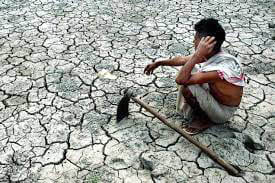Drought in Assam in 2005
Drought in Assam in 2005
Drought in Assam in 2005
Among the north-east Indian states, Assam is rich in natural resources yet the economic condition of the state is lagging behind lamentably if compared with that of the other states of India. It is basically a state of agriculture. About 70% of its population earns their livelihood by means of cultivating the land. But the cultivators, as well as the farmers of this state, are far away from having the facilities of using and applying modern scientific technologies in their agricultural works, as the Governments both of the centre and of the states are negligent and indifferent to the agricultural sector of the state. The peasants as well as the farmers of the state depend upon the grace of Nature for their weather. Every year it faces great food, which causes a huge loss of the flora and fauna.
The Northeast states of India get immense rainfall from the monsoons every year. But geologists and scientists have come to know that the climate of the earth is going to be changed unprecedentedly. And it is because of the pollution of air caused by cutting off the green trees immensely. In addition to this, the increase of the use of automobiles, factories, industries etc. also causes to increase in the percentage of carbon dioxide in the air. For these adverse circumstances, the monsoons have turned their direction and as a result, 40% of natural rain falls short in Assam.
The farmers of Assam kept waiting with curiosity and eagerness for rain but when the months of Shaun and Bhad passed off without rain, the heart and spirits of the cultivators broke down. About 10 lacks hectares of land remained uncultivated the direct loss of which was more than 1500 cores. Almost all the districts had been affected badly by the drought. Especially all the districts of west Assam faced a huge loss this year. Among the districts, the district of Barpeta, Nalbari, Kukrajhar, Dhubri, Goalpara, and Chirang had suffered the worst.
India is an agricultural country and 70% of its population is directly involved in agriculture. The agriculture sector contributes a good percentage to the Gross Domestic Product of India. But this sector, especially the cultivators, has been neglected by the Governments. Tea cultivation also falls in the agriculture sector. But we see that the government gives more facilities to the tea cultivators. There are special acts and Policies for the tea cultivators by which the owners and the labourers associated with the tea industries enjoy more protection. For the tea industries, there are such Acts as-Plantation Act, Workmen’s Compensation Act, Fatal Accident Act, Bonus Act etc. Moreover, there is Labours’ Union for the workmen of the tea gardens. But for the peasants, there are no Acts by which the majority of the Indian population may be benefited. It shows that the agriculture sector suffers from the oblique look of the stepmother.
Most of the cultivators live under the poverty line. Their only means of livelihood is agriculture. They have no alternatives. As the State Government along with the Central Government is silent in this respect, the farmers have become grieved at the government authorities. Already in many districts of Assam, the farmers have united and been showing their resentment. Taking the avail of this disaster many businessmen have taken the paths of evil which results in the rising price of necessary things as paddy, potato, chilly, onion, garlic etc. Already the price of paddy has risen up 20% in Assam. The famine is imminent. Already, in the district of Barpeta, Kukrajhar, Dhubri, Goalpara the famine have begun. All Assam Students Union and Assam Unnati Shava call upon the farmers to come out to show their grievances. In Lakhimpur, the grieved people have destroyed all the goods and documents of the District Agriculture Office. In addition to this, the agitated farmers had plowed the courtyard of the office. This kind of grievance has been shown in the district of Dhubri, Barpeta, Goalpara and some other places also. Yet the Tarun Gogoi Government seems to remain silent as it seemed since its formation. When the people suffer from the negligence of the governing authorities, then revolt takes the birth of its own hearth. History teaches us this. It seems that if the government fails to meet the legal demands of the general public then the government must face a new vehement revolt — the peasant revolt in Assam.
Here it is relevant to cite that in India, after independence, about 50 thousand of farmers committed suicide. Only in Maharashtra, during the last six months of the running year, more than a thousand farmers have met their death by suicide. In that state the farmers cultivate cotton as the cotton of the state is superior to that of other states. But since some years back the production of cotton has fallen down. As a result, the condition of the cotton farmers has deteriorated. As there is no fixed Banking policy of the government for the farmers, they were compelled to take loans from money-lenders at a high rate of interest. On the contrary, being unable to pay the loans the farmers are committing suicide. Such condition has risen up in Andhra Pradesh, Karnataka, Bihar, Haryana etc. If the government of Assam does not pay importance to the disaster of the state, then the cultivators of Assam might take the path of committing suicide. So, we draw the attention of the government to take necessary stapes erelong.
This disaster should be considered to be a disaster of the nation, not of a region and to meet the disaster; everybody must come out in a body. Scientists must come out with their technologies, and geologists and geographers must come out to find out the mystery of the causes of the disaster. The government must come out with prompt policies to rescue the forlorn farmers. The intellectualists must come out with sharp eyes to keep guard on the operation of the disaster so that no corruption can creep into the operation. Non-government Organizations also must come out with a view to render their services.
To meet the disaster, the government must take both short-term and long-term planning. Short-term planning should be taken to relieve the village farmers from the disaster immediately. And the long terms planning should be taken for permanent relief of the disaster. Among the short-term planning the government must take the following steps:
First, as most of the cultivators of Assam live below the poverty line, so they should be provided with necessary food, medicine and clothes for the year. Already the Assam Government has remitted the land rent (revenue) of the year. It is a praiseworthy step taken by the government, but the remittance of the rent is not enough, the government must remember it.
Secondly, for the next crops to be grown in the winter season, the cultivators should be provided with necessary crop seeds, manure and other fertilizer.
Thirdly, the cultivators should be supplied with a short-term loan from the bank without interest.
For the operation of these short terms planning, the government should form a special task force so that they may help the cultivators directly without making any formal (official) delay. Therefore, the consisting government force should come forward with a sympathetic heart, so that no corruption may happen.
Along with short-term planning, the government must have the following long-term planning:
First, the government must engage scientists and geologists to find out the real cause of the disaster. After finding out the causes, they must take the proper outline against the causes.
Secondly, all the things and means by which pollution of air is caused must be prevented. For this, the government must take necessary steps to increase the scope of social foresting. By means of arranging special seminars, the general people should be made aware of the degradation of the natural environment of the world so that the government may have the cooperation of the general public.
Thirdly, the factories, industries and automobiles, which emit carbon dioxide, must be banned or they should be compelled to take necessary scientific means so that the emission of the carbon-dioxide may be minimized.
It is seen that developed countries such as- America, Australia, Japan, German, France, England, China etc. are basically industrial countries and 90% of the world’s pollution is caused by these countries. Though there are necessary international Acts and Agreements yet it seems that all these countries have been showing their thumbs to the world. Now, all the countries of the world must be united against these countries and must take stern steps to make them abide by the anti-pollution act and agreements.
Fourthly, the government must take a special step to make scientific and effective channels of irrigation. More money should be allotted to this table. The central government along with the state government must work together for it.
In conclusion, it is to warn the government that the people of this state would count the success or failure of the government upon how the government treat and manage the disaster. 0 0 0.
Drought in Assam in 2005
You May Like: Positive Thought, Patience and Perseverance
Drought in Assam
N. B. The article ‘Drought in Assam in 2005’ originally belongs to the book ‘Articles on Contemporary Affairs‘ by Menonim Menonimus.
Drought in Assam
Books of Composition by M. Menonimus:
- Advertisement Writing
- Amplification Writing
- Note Making
- Paragraph Writing
- Notice Writing
- Passage Comprehension
- The Art of Poster Writing
- The Art of Letter Writing
- Report Writing
- Story Writing
- Substance Writing
- School Essays Part-I
- School Essays Part-II
- School English Grammar Part-I
- School English Grammar Part-II..
Books on Literary Criticism by M. Menonimus:
- World Short Story Criticism
- World Poetry Criticism
- World Drama Criticism
- World Novel Criticism
- World Essay Criticism
- Indian English Poetry Criticism
- Indian English Poets and Poetry Chief Features
- Emily Dickinson’s Poetry-A Thematic Study
- Walt Whitman’s Poetry-A Thematic Study
- Critical Essays on English Poetry
- Tawfiq al-Hakim’s Novel: Return of the Spirit-An Analytical Study
- Tawfiq al-Hakim’s Novel: ‘Yawmiyyat Naib Fil Arayaf’-An Analytical Study
- Analytical Studies of Some Arabic Short Stories
- A Brief History of Arabic Literature: Pre-Islamic Period (500 AD-622 AD)
- A Brief History of Arabic Literature: Early Islamic Period (622 AD-661 AD) …
Related Search:
- Assam Faces Drought Disaster
- Drought in Assam











